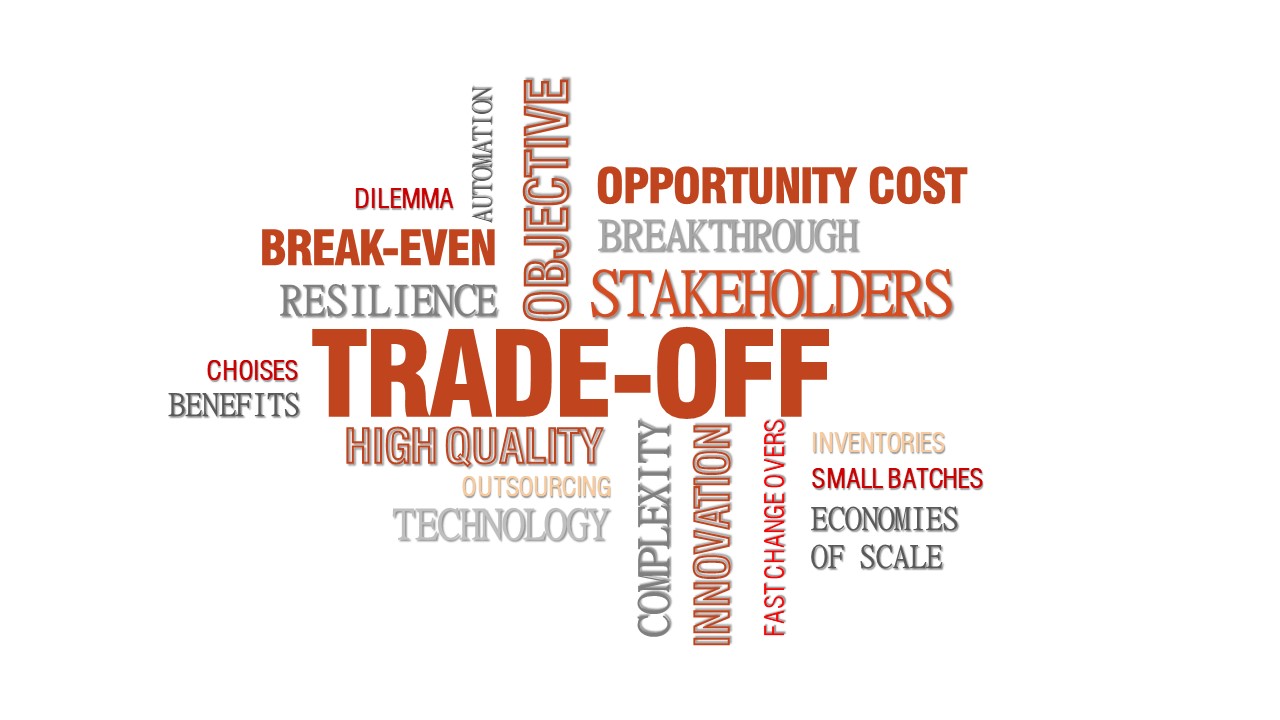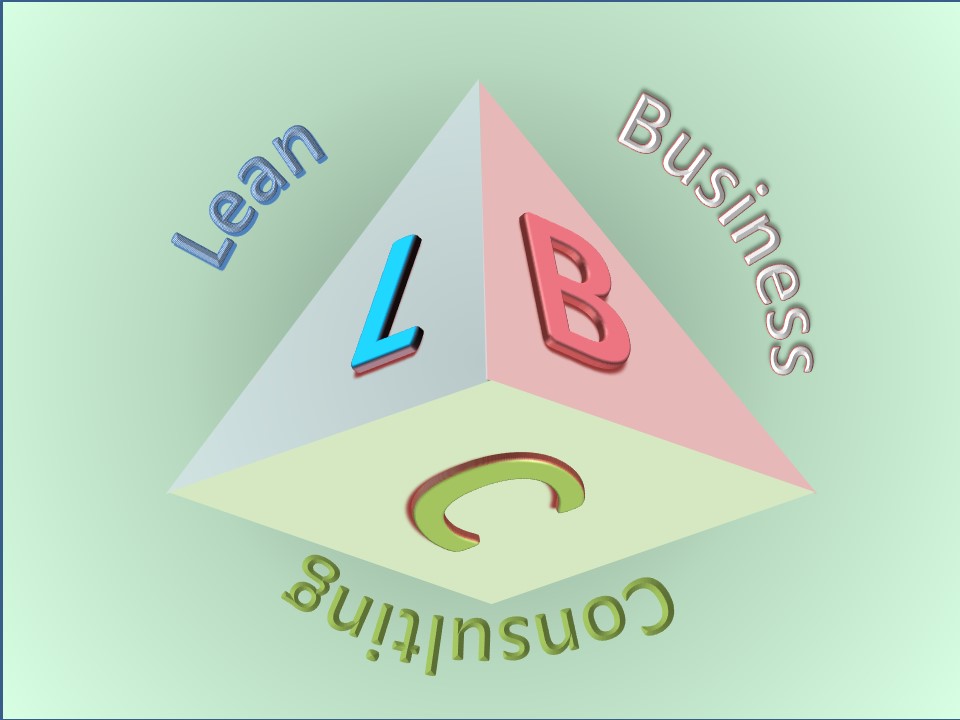Last time you were in a dilemma, you wished you could take the correct decision about the right thing to do and of course never to be in a similar situation again. Right? Well, not quite! For two reasons: Every time we have to take a decision we have to make a choice between two alternatives. There are indeed always two alternatives (may be more, not less)! Even avoiding or postponing a decision it is an alternative in itself. Whether we like it or not, life is … luckily full of dilemmas. We have to be able to recognise...
...
them early on and handle them appropriately. On the other hand, particularly in critical decisions, we should stop agonising and second-guessing about the absolute right or wrong thing to do, because there is no absolutely right thing. Every decision involves optimisation between alternatives to achieve an objective. This is called trade-off.
A trade-off, according to Wikipedia, is a situation that involves losing one quality, aspect or amount of something (also known as opportunity cost) in return of gaining another quality, aspect or amount. The latter is the benefit and should be bigger than the opportunity cost. An alternative and simpler definition is this: A trade-off is a case where you do something at the expense of something else.
A careful situation analysis is a must
Recognising the trade-off requires careful deliberation of the situation ahead, particularly because there are  almost always hidden aspects that they may reveal later on. Personal experience is essential but also asking for help is vital at this stage. Bear in mind that successful decisions heavily depend on correct analysis of the present situation.
almost always hidden aspects that they may reveal later on. Personal experience is essential but also asking for help is vital at this stage. Bear in mind that successful decisions heavily depend on correct analysis of the present situation.
Similar decisions on different situations may lead to quite opposite results. Automation implemented in production, for instance, helps in cost saving as long as proper maintenance is in place and careful streamlining of the process has been implemented. Automating the “chaos” is catastrophic.
Select the correct objective
Before deciding about a trade-off it is essential to be clear about the desired objective right from the beginning and to stick to that. This is important because the whole analysis is built on careful selection and prioritisation of the activities to achieve the objective. The objective will determine the benefits and the opportunity costs. Beside the objectives, the analysis about a trade-off requires identification of the stakeholders that will be affected by the final decision. Watch out as this may reveal further costs or benefits.
Unfortunately most trade-offs call to compare apples with pears, unless we manage to evaluate the alternatives in money terms. In this latter case we can establish the break-even points that determine how much of an alternative we can afford to give up in return of a benefit. In addition to the quantitative (mathematical) cost / benefit calculation, there are other less accurate qualitative methods. These use lists of relevant pros and cons or other more sophisticated methods such as QFD (Quality Function Deployment) that can help in decision making.
Ensure you apply the best available technology
One thing that needs further clarification is that the decision making process depends on the technology and the innovation. For instance, factories that try to reduce frequent change overs on their production lines to improve their efficiencies suffer from high inventories, delayed deliveries and low customer service. A lean factory, however, that has installed modern flexible lines and implements fast change over procedures, can reduce the production batches to reduce the stocks and boost the customer service, at relatively low production cost. Modern technology has enabled to reduce the product change over times from some hours down to a few minutes through automation. So the trade-off between the change over cost and the stock level can be turned to a competitive advantage by achieving both low change over cost and low stock levels by reducing the change over time. R. H Hayes and G. P. Pisano in their article “Beyond World Class _The new manufacturing strategy” (HBR, Jan. Feb. 1994) state clearly that “Manufacturing strategy can no longer confine itself to guiding short-term choices between conflicting priorities like cost, quality and flexibility. ... Long-term success requires that a company continually seek new ways to differentiate itself from its competitors.”
Automation enforced by artificial intelligence enables small factories to become more cost effective compared to bigger ones. This questions the traditional advantage of the economies of scale that has led to monumentally big production processes.
A couple of final examples from the everyday life. In the past you could only carry a few photos with you. Your family, your kids and your pet. Now you can carry big albums in your tablet or smartphone and share the photos with your friends. In the past you could carry only a few documents with you when you were working out of the office. Now you can get your tablet connected through the internet to your hard disk in the office, so you do not have to sacrifice any support document. Technological progress and innovation through frequent review and re-evaluation of the trade-offs, may reveal unexplored opportunities or even breakthroughs.
Stay focused
A word of caution: when you have taken a decision, don’t fall back to the zero point in order to choose the other alternative. This is a terrible waste of effort and time. Moreover, bear in mind that taking a decision is not the end of the story. There is a hell of a lot of things that you have to do, to reap the benefits of your decision but you have to work with passion and resilience.
Never be scared by the trade-offs. You cannot escape them, only handle them cautiously. Make sure you have a clear objective and have located all the stakeholders. This will help you to lay out and evaluate the alternatives. Try to always implement innovative thinking; this will maximise your benefits. In the end take a decision and prioritise your activities. Work meticulously with commitment to achieve your objective and stop second-thinking. Chances are that you will be finally a lot better than before. And remember: trade-offs are all around you. The question sometimes is whether you are willing to trade what you have and what you know for a new opportunity.
14/10/2017
Alkis Charalambopoulos, www.leansolutions.gr
Keywords
Trade-off, dilemma, opportunity cost, benefit, objective, decision making, innovation, technology, competitive advantage

